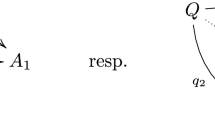Abstract
Collections of objects and morphisms that fail to form categories, inasmuch as the expected composites of two morphisms need not always be defined, were introduced in [14,15] under the name composition graphs. In [14,16], notions of adjunction and weak adjunction for composition graphs are proposed. Building on these definitions, we now introduce a concept of monads for composition graphs and show that the usual correspondence between adjunctions and monads remains correct, i.e. that (weak) adjunctions give rise to monads and that all monads are induced by adjunctions. Monads are described in terms of natural transforms as well as in terms of Kleisli triples, which seem to be better suited in the absence of associativity. The realization of a monad by an adjunction relies on a generalization of the Kleisli construction to composition graphs; on the other hand, the Eilenberg–Moore construction produces only a weak adjunction and admits comparison functors from weak adjunctions. As a first nontrivial example, we determine the algebras of the word monad on the composition graph of full morphisms between sets with a distinguished subset.
Similar content being viewed by others
References
Adamek, J., Herrlich, H., and Strecker, G. E.: Abstract and Concrete Categories, Wiley Interscience, New York, 1990.
Coppey, L.: Décompositions directes des précategories, Math. Arbeitspapiere der Universität Bremen 7 (1976), 26–41.
Coppey, L.: Quelques problèmes typiques concernant les graphes multiplicatifs, Diagrammes 3 (1980), C1–C46.
Ehresmann, C.: Catégories et Structures, Dunod, Paris, 1965.
Eilenberg, S. and Moore, J. C.: Adjoint functors and triples, Illinois J.Math. 9 (1965), 381–398.
Graetzer, G.: Universal Algebra, 2nd edn, Springer-Verlag, Berlin, 1979.
Herrlich, H. and Strecker, G. E.: Category Theory, Heldermann, Berlin, 1979.
Kleisli, H.: Every standard construction is induced by a pair of adjoint functors, Proc. Amer. Math. Soc. 16 (1065), 544–546.
Knauer, U. and Böttcher, M.: Endomorphism spectra of graphs, Discrete Math. 109 (1992), 45–57.
Mac Lane, S.: Categories for the Working Mathematician, Springer, Berlin, 1971.
Manes, E. G.: Algebraic Theories, Springer, Berlin, 1976.
Mateus, P., Sernadas, A., and Sernadas, C.: Precategories for combining probabilistic automata, Electron. Notes Theor. Comput. Sci.29 (1999).
Moggi, E.: Notions of computation and monads, Inform. and Comput. 93 (1991), 55–92.
Schröder, L.: Composition graphs (in German), PhD Thesis, University of Bremen, 1999; also: Logos, Berlin, 1999.
Schröder, L. and Herrlich, H.: Free adjunction of morphisms, Appl. Cat. Struct. 8 (2000), 595–606.
Schröder, L. and Mateus, P.: Universal aspects of probabilistic automata, Submitted for publication.
Author information
Authors and Affiliations
Rights and permissions
About this article
Cite this article
Schröder, L. Monads on Composition Graphs. Applied Categorical Structures 10, 221–236 (2002). https://doi.org/10.1023/A:1015200105427
Issue Date:
DOI: https://doi.org/10.1023/A:1015200105427




